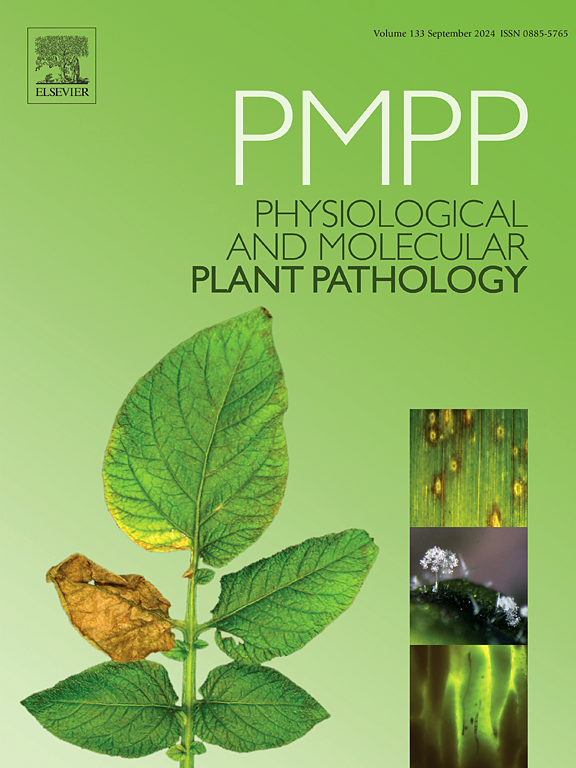Establishing an efficient protoplast isolation and PEG-mediated transformation system for functional genomic studies in Colletotrichum lindemuthianum
IF 2.8
3区 农林科学
Q2 PLANT SCIENCES
引用次数: 0
Abstract
Colletotrichum lindemuthianum is a significant threat to global bean production. The increasing availability of genomic data has led to a substantial accumulation of knowledge regarding the pathogenicity determinants in C. lindemuthianum, particularly focusing on effector proteins. A highly efficient transformation system is essential to effectively characterize these effectors and elucidate the molecular mechanisms behind C. lindemuthianum pathogenesis. The Agrobacterium-mediated transformation method has proven ineffective for site-directed mutagenesis in C. lindemuthianum. Additionally, the enzymes previously used for protoplast isolation are no longer accessible. We developed a highly efficient method for producing protoplasts using a new set of enzymes from the virulent C. lindemuthianum race 2047. The study involves generating and regenerating viable protoplasts from conidial and mycelial cultures. We treated the conidia of race 2047 with various combinations of enzymes and osmotic agents. Our results showed that a combination of 20mg/ml of Driselase and 1M D-sorbitol yielded the highest number of viable protoplasts. The treatment of 3g mycelial with 1.2g VinoTaste Pro in 30ml of buffer (0.6M (NH4)2S04, 50mM maleic acid, pH 5.5), yielded 5.8 ± 0.54 × 107protoplasts/g of mycelium, with 85% viability. Isolated protoplasts were transformed with the pBV367 vector and regenerated onto a TB3 medium. The transformants selected for G418 antibiotic resistance colonies were monitored for mRFP1 expression. The protocol achieved a transformation efficiency ranging from 56 to 110 transformants/μg of plasmid DNA. The phenotypic bioassay of ten randomly selected transformants depicted no significant difference between the wild-type race 2047 and the transformants. Additionally, the mRFP1 tagging allowed for accurate fluorescence microscopy visualization of the infection process. This robust transformation method provides a solid foundation for functional genomic studies, including gene knockout and site-directed mutagenesis in C. lindemuthianum.
建立高效原生质体分离及peg介导转化体系用于炭疽病功能基因组研究
炭疽病菌是全球豆类生产的重大威胁。越来越多的基因组数据的可用性导致了大量的知识积累,关于C. lindemuthianum致病性决定因素,特别是集中在效应蛋白。一个高效的转化系统对于有效地表征这些效应物和阐明lindemuthianum发病机制背后的分子机制至关重要。农杆菌介导的转化方法已被证明对C. lindemuthianum的定点诱变无效。此外,以前用于原生质体分离的酶不再可用。利用毒力强的C. lindemuthianum品种2047的一套新酶,建立了一种高效生产原生质体的方法。该研究涉及从分生孢子和菌丝培养中产生和再生有活力的原生质体。用不同的酶和渗透剂组合处理2047小种的分生孢子。结果表明,20mg/ml的Driselase和1M的d -山梨醇的组合产生的原生质体数量最多。用1.2g VinoTaste Pro在30ml缓冲液(0.6M (NH4)2S04, 50mM马来酸,pH 5.5)中处理3g菌丝,产生5.8±0.54 × 107个原生质体/g菌丝,存活率为85%。将分离的原生质体用pBV367载体转化,并在TB3培养基上再生。选择G418耐药菌落的转化子监测mRFP1的表达。该方法实现了56 ~ 110个转化子/μg质粒DNA的转化效率。对10个随机选择的转化子进行表型生物测定,结果表明野生型品种2047与转化子之间无显著差异。此外,mRFP1标记允许对感染过程进行精确的荧光显微镜可视化。这种强大的转化方法为C. lindemuthianum的功能基因组研究提供了坚实的基础,包括基因敲除和定点突变。
本文章由计算机程序翻译,如有差异,请以英文原文为准。
求助全文
约1分钟内获得全文
求助全文
来源期刊
CiteScore
4.30
自引率
7.40%
发文量
130
审稿时长
38 days
期刊介绍:
Physiological and Molecular Plant Pathology provides an International forum for original research papers, reviews, and commentaries on all aspects of the molecular biology, biochemistry, physiology, histology and cytology, genetics and evolution of plant-microbe interactions.
Papers on all kinds of infective pathogen, including viruses, prokaryotes, fungi, and nematodes, as well as mutualistic organisms such as Rhizobium and mycorrhyzal fungi, are acceptable as long as they have a bearing on the interaction between pathogen and plant.

 求助内容:
求助内容: 应助结果提醒方式:
应助结果提醒方式:


